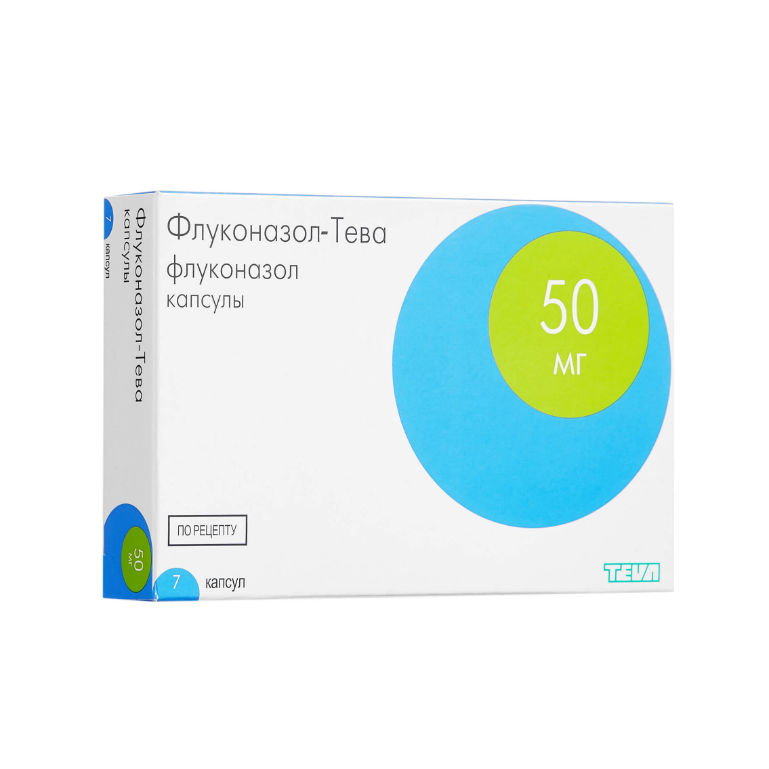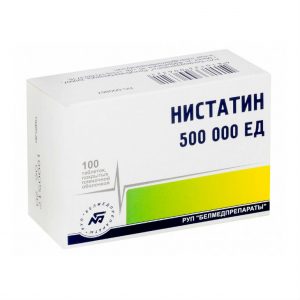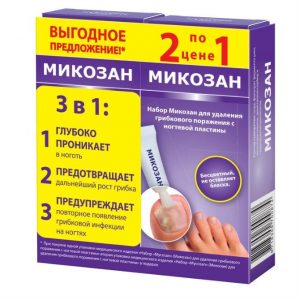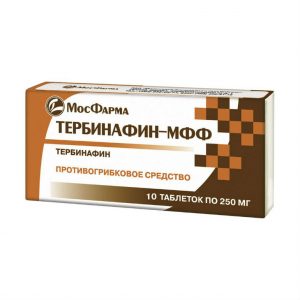Description
Release form
Capsules
Packing
7 pcs.
Pharmacological action
Antifungal, triazole derivative. It is a selective inhibitor of sterol synthesis in the fungal cell. Fluconazole is highly specific for fungal enzymes dependent on cytochrome P450.
When administered orally and with iv, fluconazole was active in various models of fungal infections in animals.
Fluconazole is active in opportunistic mycoses, including caused by Candida spp., including generalized candidiasis in animals with reduced immunity of Cryptococcus neoformans, including intracranial infections of Microsporum spp. and Trychoptyton spp. It is active in animal endemic mycoses models, including infections caused by Blastomyces dermatitidis, Coccidioides immitis, including intracranial infections, and Histoplasma capsulatum in animals with normal and reduced immunity.
Indications
Cryptococcosis, including cryptococcal meningitis and other localizations of this infection (including lungs, skin), both in patients with a normal immune response and in patients with various forms of immunosuppression (including in patients with AIDS , for organ transplantation) the drug can be used to prevent cryptococcal infection in AIDS patients
generalized candidiasis, including candidaemia, disseminated candidiasis and other forms of invasive candida infections (infections of the peritoneum, endocardium, eyes, respiratory and urinary tract). Treatment can be carried out in patients with malignant neoplasms, patients in the intensive care unit, patients undergoing a course of cytostatic or immunosuppressive therapy, as well as in the presence of other factors predisposing to the development of candidiasis
candidiasis of the mucous membranes, including the oral cavity and pharynx (including atrophic candidiasis of the oral cavity associated with wearing dentures), the esophagus, non-invasive bronchopulmonary candidiasis, candiduria, skin candidiasis prevention of recurrence of oropharyngeal candidiasis in AIDS patients
genital candidiasis: vaginal candidiasis (acute and chronic relapsing) prophylactic use to reduce the recurrence rate of vaginal candidiasis (3 or more episodes per year) candidal balanitis
prevention of fungal infections in patients with malignant neoplasms who are predisposed to such infections as a result of chemotherapy with cytostatics or radiation therapy of
mycosis of the skin, including foot mycosis, body , inguinal area, pityriasis (multicolored) lichen, onychomycosis candidiasis of the skin
deep endemic mycoses, including coccidioidomycosis, paracoccidiomycosis, sporotrichosis and gy toplazmoz in patients with normal immune systems.
Contraindications
Hypersensitivity to the drug (including a history of other azole antifungal drugs)
simultaneous administration of terfenadine (with continuous administration of fluconazole at a dose of 400 mg / day or more) or astemizole, as well as other drugs, QT
children under 4 years old.
Caution:
Special instructions
Treatment must be continued until clinical hematological remission occurs. Premature discontinuation of treatment leads to relapse.
During treatment, it is necessary to monitor blood counts, kidney and liver function. If there is a violation of the kidneys and liver, you should stop taking the drug.
In rare cases, the use of fluconazole was accompanied by toxic changes in the liver, including fatal, mainly in patients with serious concomitant diseases. In the case of hepatotoxic effects associated with fluconazole, there was no obvious dependence on the total daily dose, duration of therapy, gender and age of the patient. The hepatotoxic effect of fluconazole was usually reversible, its signs disappeared after discontinuation of therapy. If there are clinical signs of liver damage that may be associated with fluconazole, the drug should be discontinued.
AIDS patients are more likely to develop severe skin reactions when using many drugs. In cases where a rash develops in patients with superficial fungal infection and is regarded as definitely associated with fluconazole, the drug should be discontinued. When a rash appears in patients with invasive / systemic fungal infections, they should be carefully monitored and fluconazole should be discontinued when bullous changes or erythema multiforme occur.
Caution must be exercised while taking fluconazole with cisapride, rifabutin, or other drugs metabolized by the cytochrome P 450 system.
Composition
1 capsule contains:
Active ingredient: fluconazole 50 mg
Excipients: lactose monohydrate starch pregelatinized silica colloidal anhydrous magnesium sodium stearate lauryl sulfate.
Composition of the shell of the gelatin capsule: titanium dioxide (E171), gelatin.
Composition of the capsule of the gelatin capsule: titanium dioxide (E171), brilliant blue FCF (E133), gelatin.
Side effects of the
Digestive system: loss of appetite, taste changes, abdominal pain, vomiting, nausea, diarrhea, flatulence, rarely – impaired liver function (jaundice, hepatitis, hepatitis, hepatitis, hepatitis, hepatitis, hepatitis, hepatitis, hepatitis, hepatitis, hepatitis, hepatitis, hepatitis, hepatitis, hepatitis, hepatitis, hepatitis, hepatitis, hepatitis, hepatitis, hepatitis, hepatitis, hepatitis, hepatitis, hepatitis, hepatitis, hepatitis, hepatitis, hepatitis alanine aminotransferase, aspartate aminotransferase, increased activity of alkaline phosphatase, hepatocellular necrosis), including heavy.
From the nervous system: headache, dizziness, excessive fatigue, rarely – cramps.
From the hemopoietic organs: rarely – leukopenia, thrombocytopenia (bleeding, petechiae), neutropenia, agranulocytosis.
Allergic reactions: skin rash, rarely erythema multiforme exudative (including Stevens-Johnson syndrome), toxic epidermal necrolysis (Lyell’s syndrome), anaphylactoid reactions (including angioedema, swelling of the face, urticaria, pruritus )
From the cardiovascular system: an increase in the duration of the QT interval, ventricular fibrillation / flutter.
Other: rarely – impaired renal function, alopecia, hypercholesterolemia, hypertriglyceridemia, hypokalemia.
Drug interactions
When using fluconazole with warfarin, the increase in PV (an average of 12%). In this regard, it is recommended to carefully monitor the PV indicators in patients receiving the drug in combination with coumarin anticoagulants.
Fluconazole increases the plasma half-life of oral hypoglycemic agents – sulfonylurea derivatives (chlorpropamide, glibenclamide, glipizide, tolbutamide) in healthy people. The combined use of fluconazole and oral hypoglycemic agents in patients with diabetes is allowed, but the doctor should keep in mind the possibility of developing hypoglycemia.
The simultaneous use of fluconazole and phenytoin can lead to an increase in plasma phenytoin concentration to a clinically significant degree. Therefore, if it is necessary to use these drugs together, it is necessary to monitor the concentration of phenytoin with dose adjustment in order to maintain the level of the drug within the therapeutic interval.
Combination with rifampicin leads to a decrease in AUC by 25% and to shorten the half-life of fluconazole from plasma by 20%. Therefore, it is advisable to increase the dose of fluconazole in patients receiving rifampicin simultaneously.
It is recommended to monitor the concentration of cyclosporine in the blood in patients receiving fluconazole, as the use of fluconazole and cyclosporine in patients with a transplanted kidney (taking fluconazole at a dose of 200 mg / day) leads to a slow increase in the concentration of cyclosporine in the plasma.
Patients who receive high doses of theophylline or who are likely to develop theophylline intoxication, should be monitored for the early detection of symptoms of theophylline overdose, as taking fluconazole leads to a decrease in the average clearance rate of theophylline from plasma.
With the simultaneous use of fluconazole with terfenadine and cisapride, cases of adverse reactions from the heart, including paroxysms of ventricular tachycardia (torsades de points), have been described.
The simultaneous use of fluconazole and hydrochlorothiazide can lead to an increase in the concentration of fluconazole in plasma by 40%.
There are reports of the interaction of fluconazole and rifabutin, accompanied by an increase in serum levels of the latter. With the simultaneous use of fluconazole and rifabutin, cases of uveitis have been described. It is necessary to carefully observe patients simultaneously receiving rifabutin and fluconazole.
In patients receiving a combination of fluconazole and zidovudine, an increase in the concentration of zidovudine is observed, which is caused by a decrease in the conversion of the latter to its main metabolite, therefore, an increase in side effects of zidovudine is expected.
Increases the concentration of midazolam, and therefore increases the risk of psychomotor effects (most pronounced when using fluconazole orally than iv).
Increases the concentration of tacrolimus, and therefore the risk of nephrotoxicity increases.
Overdose
Symptoms: hallucinations, paranoid behavior.
Treatment: symptomatic – gastric lavage, forced diuresis. Hemodialysis reduces plasma concentrations by about 50% for 3 hours.
Storage Conditions
In a dry, dark place at 15 25 ° C.
active substance
Fluconazole
Dosage form
capsule
Indications
Indications
from yeast
Teva Pharmaceutical Enterprise Co., Ltd., Israel




